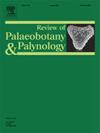华南石松砧木的密西西比新材料:该化石属解剖保守性的证据
IF 1.7
3区 地球科学
Q2 PALEONTOLOGY
引用次数: 0
摘要
石炭-二叠纪煤沼泽森林的重要组成部分——木本石松属的地下生根系统代表了石炭-二叠纪煤沼泽森林的重要组成部分。对stistimaria的形态和解剖已经进行了广泛的研究,主要是基于保存完好的欧美宾夕法尼亚系材料,但对其前宾夕法尼亚期特征、分类和进化历史的了解仍有待扩大。本文报道了贵州陇里维尚(密西系)香白组的新材料,并将其分类为Stigmaria cf. s.f icoides (Sternberg) Brongniart。本植物的特点是脐状的根茎疤痕,它们在根茎周围螺旋状排列。其解剖结构为螺线管,由内弓初生木质部和径向排列的次生木质部组成。皮层分为五个区域,但没有周皮。根状维管束呈三角形,从内皮层向根状表面伸出。我们的发现代表了最早的两个记录之一,并保留了解剖结构。另一个Visean记录(Glenarbuck, England)的材料有限,因此在我们的植物中显示的更多解剖特征最早是在前宾夕法尼亚时代的stistimaria中发现的。这些Visean记录显示,在解剖学上,与宾夕法尼亚和二叠纪的stistimaria ficoides材料非常相似,表明该化石属在解剖学上的保守性和长期的进化停滞。本文章由计算机程序翻译,如有差异,请以英文原文为准。
New Mississippian materials of the lycopsid rootstock Stigmaria Brongniart from South China: Evidence for anatomical conservatism in this fossil-genus
The fossil-genus Stigmaria Brongniart represents the underground rooting system of arborescent lycopsids, which were important elements in coal-swamp forests during the Carboniferous to Permian periods. The morphology and anatomy of Stigmaria have been extensively studied, mainly based on well-preserved materials from the Pennsylvanian of Euramerica, but knowledge about its pre-Pennsylvanian characters, taxonomy, and evolutionary history remains to be expanded. Here, new materials of Stigmaria are described from the Visean (Mississippian) Xiangbai Formation of Longli, Guizhou, southwestern China and are classified into Stigmaria cf. S. ficoides (Sternberg) Brongniart. Our plant is characterized by navel-shaped rootlet scars, which are arranged helically around rhizomorphs. Its anatomy shows a solenostele with endarch primary xylem and radially aligned secondary xylem, which is divided into wedge-shaped segments by rootlet traces. The cortex is divided into five zones, but there is no periderm. Rootlet vascular bundles are triangular monarch, protruding from the inner cortex to the rhizomorph surface. Our find represents one of the two earliest records of Stigmaria with anatomy preserved. The other Visean record (Glenarbuck, England) is represented by limited material, and thus many more anatomical features demonstrated in our plant are first known in the pre-Pennsylvanian Stigmaria. These Visean records demonstrate great similarities in anatomy with the Pennsylvanian and Permian materials of Stigmaria ficoides, indicating anatomical conservatism and long-term evolutionary stasis in this fossil-genus.
求助全文
通过发布文献求助,成功后即可免费获取论文全文。
去求助
来源期刊
CiteScore
3.50
自引率
21.10%
发文量
149
审稿时长
6 months
期刊介绍:
The Review of Palaeobotany and Palynology is an international journal for articles in all fields of palaeobotany and palynology dealing with all groups, ranging from marine palynomorphs to higher land plants. Original contributions and comprehensive review papers should appeal to an international audience. Typical topics include but are not restricted to systematics, evolution, palaeobiology, palaeoecology, biostratigraphy, biochronology, palaeoclimatology, paleogeography, taphonomy, palaeoenvironmental reconstructions, vegetation history, and practical applications of palaeobotany and palynology, e.g. in coal and petroleum geology and archaeology. The journal especially encourages the publication of articles in which palaeobotany and palynology are applied for solving fundamental geological and biological problems as well as innovative and interdisciplinary approaches.

 求助内容:
求助内容: 应助结果提醒方式:
应助结果提醒方式:


